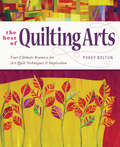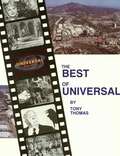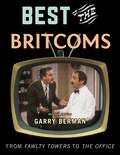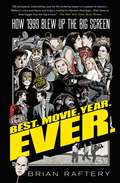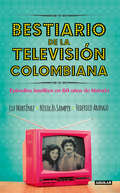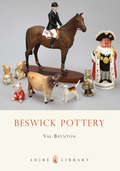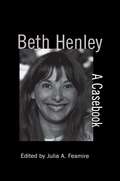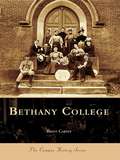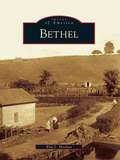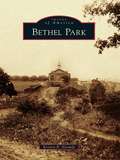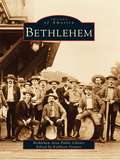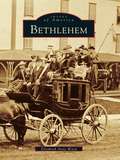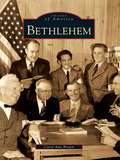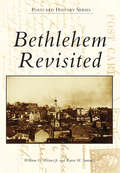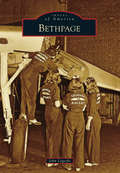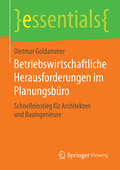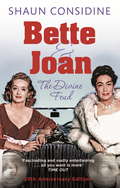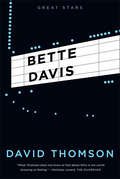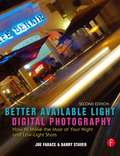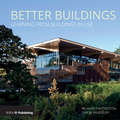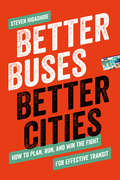- Table View
- List View
Best of Quilting Arts: Your Ultimate Resource for Art Quilt Techniques and Inspiration
by Pokey BoltonCelebrate the first 10 years of the groundbreaking Quilting Arts magazine with a collection of the best articles, projects, and techniques.Pokey Bolton, founder of Quilting Arts magazine, has compiled the most popular articles that have inspired quilters and artists alike to move beyond the basics of art quilting and re-explore machine and hand stitching, fabric embellishment, surface design, and more. Inside you'll find:quilt art techniques from fabric collage and appliqué to resist dyeing, stamping, and foilingmachine-stitching and thread-painting tips and tutorials from award-winning art quiltersideas and advice for the professional quilt artistan array of binding and stitching techniques to make your art quilt stand outmethods for making realistic representational art quilts, including portraits of pets and people. Whether you're making your first art quilt or are a seasoned quilt artist eager to enhance your designs, you'll find endless instruction and inspiration in The Best of Quilting Arts.
Best of Stitch - Beautiful Bedrooms
by Amber EdenBrighten up your boudoir with twenty sewing projects! Stitch magazine readers can't get enough of pillows and other home-decor accessories. Perhaps it's because home-decor items are among the most accessible of sewing projects: quick to make, no fitting required, and fun to show off. And what better place to use and showcase these items than where you lay your head? Best of Stitch: Beautiful Bedrooms brings together a colorful, sensory feast of favorite and fresh projects that are easy on the eye and just a little bit sultry. You will learn new skills and find creative ways to make your sleeping quarters a showplace for handmade items. The book includes twenty projects as well as tips and sidebars on special techniques and troubleshooting advice for construction, handstitching, working with fabrics, and embellishing. A "Sewing Basics" reference section at the back of the book covers the skills necessary for creating each project.
Best of Stitch: Bags to Sew
by Tricia WaddellExpress your unique style with 20 fun and fabulous bags to stitch! Welcome to a selection of the best bags from the popular Stitch magazine, plus 5 brand-new projects, curated by its editors. The book features designs from Malka Dubrawsky, Ayumi Takahashi, Kevin Kosbab, Carol Zentgraf, and many more. Techniques include patchwork, applique, pleating, creating dimension with fabric, and embroidery. Bags of a variety of shapes and sizes were selected, including coin purses, gadget bags, clutches, slouch bags, and messenger bags, so you are sure to find something to make for yourself or give to your friends and family. Inside you will find all of the best bags from Stitch magazine in one place, plus 5 brand-new designs- there's something for everyone!
Best of Universal
by Tony ThomasThe fascinating story of Universal Studios from its beginning in 1912 to the present day.
Best of the Britcoms: From Fawlty Towers to The Office
by Garry BermanWith crisp dialog, outrageous characters, and an absurd sense of humor, it's no wonder British sitcoms are so well-loved! Best of the Britcoms covers the most noteworthy situation comedies ever to cross the pond. Each entry combines a show summary with descriptions of standout episodes and behind-the-scenes details, plus gives you production data and full cast listings. And now, the revised edition of this Britcom classic contains seven new chapters on programs that have aired in the U.S. since the original edition was published, such as The Office, Extras, and My Family. Fans of old-school Britcoms won't be disappointed either, as the revised edition also includes the later developments of older series' storylines and detailed information on specials and cast reunions that have occurred in the intervening years. Pick up this book, kick back, and get to know a Britcom!
Best. Movie. Year. Ever.: How 1999 Blew Up the Big Screen
by Brian RafteryFrom a veteran culture writer and modern movie expert, a celebration and analysis of the movies of 1999—arguably the most groundbreaking year in American cinematic history.In 1999, Hollywood as we know it exploded: Fight Club. The Matrix. Office Space. Election. The Blair Witch Project. The Sixth Sense. Being John Malkovich. Star Wars: The Phantom Menace. American Beauty. The Virgin Suicides. Boys Don’t Cry. The Best Man. Three Kings. Magnolia. Those are just some of the landmark titles released in a dizzying movie year, one in which a group of daring filmmakers and performers pushed cinema to new limits—and took audiences along for the ride. Freed from the restraints of budget, technology (or even taste), they produced a slew of classics that took on every topic imaginable, from sex to violence to the end of the world. The result was a highly unruly, deeply influential set of films that would not only change filmmaking, but also give us our first glimpse of the coming twenty-first century. It was a watershed moment that also produced The Sopranos; Apple’s Airport; Wi-Fi; and Netflix’s unlimited DVD rentals. Best. Movie. Year. Ever. is the story of not just how these movies were made, but how they re-made our own vision of the world. It features more than 130 new and exclusive interviews with such directors and actors as Reese Witherspoon, Edward Norton, Steven Soderbergh, Sofia Coppola, David Fincher, Nia Long, Matthew Broderick, Taye Diggs, M. Night Shyamalan, David O. Russell, James Van Der Beek, Kirsten Dunst, the Blair Witch kids, the Office Space dudes, the guy who played Jar-Jar Binks, and dozens more. It’s the definitive account of a culture-conquering movie year none of us saw coming…and that we may never see again.
Bestiario de la televisión Colombiana
by Federico ArangoEl cumpleaños número 60 de la televisión colombiana ha servido pararecordar sus más destacados momentos. Este libro pretende todo locontrario: rendirle homenaje a una serie de personajes que más queprotagonistas, casi siempre fueron antagonistas; proyectos que muchoprometieron y nada cumplieron, así como a pintorescas adaptacioneslocales de formatos foráneos que, no por jamás haber ganado un IndiaCatalina o no haber alcanzado la portada de las famosas revistas defarándula, han sido olvidados por los más devotos televidentes. Enresumen, en tiempos en los que el país asume el reto de darle una nuevamirada más incluyente a su pasado, la televisión no se puede quedaratrás y eso es lo que se propone este libro: valorar el aporte depersonajes como Guri-Guri, Farzán, Rapidol o Milipico, resaltar laimportancia de artefactos orgullo de la tecnología criolla como elCuchuflí o la Bocina de Carlina. Y sacar de la papelera de reciclajemental fastuosas megaproducciones como La Dama del pantano, ParaísoTropical o Higuita: Sangre, sudor y lágrimas
Besties
by Leah Reena GorenA fully illustrated celebration of female friendship that is a gift, a thank-you note, and a love letter all in one. Besties smartly captures all the reasons why best friends are . . . well, the best: they help you make decisions, are there through rough patches, and will always be your +1 for awkward parties. Even more than that, best friends are the people with whom dearest memories are shared, whether trivial or meaningful. In a style that is at turns both sweet and quirky, celebrated indie artist Leah Goren illustrates the many ways in which close friendships withstand the test of time, cross-country moves, failed romantic relationships, and silly arguments. Featuring whimsical artwork and a sincere message, this is the book friends both young and mature will want to give each other to show their appreciation.
Beswick Pottery
by Val BayntonBeswick is typical of the numerous small scale ceramic factories founded towards the end of the Victorian era and manufacturing through the first two thirds of the 20th century. Like many of these companies Beswick produced a mix of tableware and sculptural ceramics adjusting its designs to take account of the trends of each decade. However the company is atypical by the very fact of its survival - in spite of the many upheavals which have transformed the ceramic industry during the latter part of the 20th century. Its story is one of evolution from a traditional Victorian Pottery to a 21st century brand.Founded in 1894 by James Wright Beswick, Beswick passed through three generations of family ownership before becoming part of Royal Doulton in 1969 and is now independently owned. As owners and collectors of its products will testify, Beswick aimed, and still aims today, to produce well made ceramics at affordable prices; wares which could be used daily in the home as well as decorative ornaments for animal lovers of all ages to cherish. In this volume Val Baynton explores the diversity of products revealing that far more than horses - for which Beswick was so justifiably famous - were made. Wares are placed in context with the company history and information on important sculptors and designers is also included.
Beth Henley: A Casebook (Casebooks on Modern Dramatists #33)
by Julia A. FesmireBeth Henley was awarded the Pulitzer Prize in Drama and the New York Drama Critics Circle Award for Best American Play for her first full-length play, Crimes of the Heart, yet there has been no book-length consideration of her body of work until now. This volume includes original essays that contextualize and analyze her works from a variety of perspectives, focusing on her vexed status as a southern writer, her use of the comic grotesque, and her alleged feminist critiques of modern society. Receiving special attention are lesser-known plays which are crucial to understanding Henley's development as a playwright and postmodern thinker.
Bethany College
by Brent CarneyHarbored in the halls of ivy-covered buildings, the rich history of Bethany College has inspired thousands of students to pursue higher education amidst the scenic Allegheny foothills. Those who have studied here have come to find that this picturesque, 1,600-acre campus has provided them with more than just a diploma-it has enriched their lives.Founded on March 2, 1840, by Alexander Campbell, Bethany College is the oldest degree-granting institution in West Virginia. Emphasizing intellectual freedom, diversity, personal growth, leadership, and a close academic community capable of cultivating eager minds, Bethany College is dedicated to providing a well-rounded education and producing free-thinking students. In these pages, readers will discover the Bethany of the past-including the vision of founder Alexander Campbell, the inspiration of the Christian Church that supports Bethany's mission, the beautiful historic architecture, the athletic moments that rallied school pride, and the great legacy of alumni and faculty. Accompanied by informative captions, vintage photographs collected from the Archives and Special Collections of the T.W. Phillips Memorial Library capture the Bethany experience, offering readers a unique opportunity to celebrate this institution's vibrant history.
Bethel (Images of America)
by Rita J. SheehanThe town of Bethel is located in Sullivan County, 90 miles northwest of New York City. Bethel was established on March 27, 1809, and the first hotel in the county opened in the hamlet of White Lake in 1846. Hundreds of hotels were to follow, from the Arlington to the Woodlawn Villa. During the silver and golden ages, White Lake became fashionable, and many people flocked to the clean water of the lake, fresh mountain air, and grand hotels. The tanneries, gristmills, and sawmills were prosperous during the 1800s. In 1969, Bethel was the site of the Woodstock Music and Arts Fair that drew nearly 500,000 people to the town. Through vintage images, Bethel recalls this town's vibrant past.
Bethel Park
by Kristen R. NormileAlthough once part of a much larger area of southwestern Pennsylvania, Bethel Park has carved its niche into the rolling hills of Allegheny County with its rich history, interesting stories, and fascinating people. Incorporated in 1886 as Bethel Township, Bethel Park has seen its landscape prosper and change from agricultural to industrial and finally into the largest populated suburb in Allegheny County's South Hills neighborhoods. Advances in transportation and industry transformed Bethel Park into an inviting community of family homes, distinguished schools, and well-established local businesses. Bethel Park was also one of the key sites in the famed Whiskey Rebellion; the location of the first documented armored car robbery; the burial site of famed pop artist Andy Warhol; and the home of well-known writer, producer, and narrator Rick Sebak.
Bethlehem
by Kathleen Stewart Bethlehem Area Public LibraryBethlehem, Pennslyvania, has a fascinating history that is steeped in tradition. The city was founded in 1741 by the Moravians, a Protestant group. They envisioned Bethlehem as an industrial center, a support center for missionaries, and as the headquaters for the Moravian Church in North America. Bethlehem became all of this and more. Moravian traditions are still strong in this town, from the preservation of the original stone buildings on Church Street to the sounds of the Trombone Choir on Easter morning. Yet with the arrival of industrialists and immigrants to the area, Bethlehem evolved into something more. Canals, railroads, steel mills, and silk mills all became part of the city' story. The little town grew into a city with a diverse population. In the process, Bethlehem eveolved into a graceful place, famous for its institutions of higher learning, for steel production, and for Bach. Bethlehem covers the period between 1845 through 1990. It is a reinterpretation of teh photograph exhibit that graced the windows of the Bethlehem Area Public Library during the city's 250th anniversary celebration. The original exhibit consisted of 350 photographs, selected from more than 600 submitted by area residents. This book includes a selection of 217 photographs from that exhibit.
Bethlehem
by Elizabeth Anne WardOne hundred years ago, the White Mountains were America's favorite resort. Presidents, writers, artists, industrialists, and prominent individuals of all types came to stay in the grand hotels and enjoy the recreation and scenery. Bethlehem, New Hampshire, was in the center of all this activity. With more than thirty hotels and lodging places, the town became synonymous with summer leisure and relaxation. Visitors enjoyed golf, tennis, riding, scenic drives, balls and gala events, and lots of rocking chair time on the wide verandahs. Fresh, pollen-free air gave relief to those suffering from asthma and hay fever. P.T. Barnum called the annual coaching parades "the second greatest show on earth." By the 1920s, the automobile and expanded travel opportunities to the West and to Europe were forcing the grand hotels into decline. Fortunately for Bethlehem, the New York Jewish community discovered the town. Bethlehem became an almost entirely Jewish resort and prospered as such until the 1970s. Even today, several hotels cater to a small Hassidic population, and the Bethlehem Hebrew congregation is a small but active year-round Jewish community. In recent years Bethlehem has undergone a rebirth of sorts, with the renovation of historical buildings, the formation of a heritage society, and the renewal of interest and pride in Bethlehem's rich and colorful history.
Bethlehem (Images of America)
by Carol Ann BrownSettled in 1734, Bethlehem is a typical Litchfield hill town and retains much of its rural charm. Around its green are an old post tavern at the Woodward House, two historic churches, and the Bellamy-Ferriday House and Garden. Rev. Joseph Bellamy came to Bethlehem in 1738 and stayed to establish the first theological school in the country, educating Aaron Burr, James Morris, and later John C. Calhoun. In 1938, postmaster Earl Johnson designed a rubber stamp to adorn cards sent from the post office attached to his family's general store. This first cachet became an annual project and established Bethlehem as "the Christmas town." In 1946, two Benedictine nuns came to stay with artist Lauren Ford while establishing the Abbey of Regina Laudis in a factory donated by local businessman Robert Leather. Every September for the last 85 years, the Bethlehem Fair has welcomed more than 60,000 people to apple pies and horse draws at its scenic fairgrounds.
Bethlehem Revisited
by Karen M. Samuels William G. Weiner Jr.Due in part to the Lehigh Canal and the Lehigh Valley Railroad, Bethlehem evolved from a tranquil town to a modern industrial city. Built in 1829, the Lehigh Canal passed by the center of Bethlehem. With it brought a steady stream of outsiders who shaped and changed the community. The Lehigh Valley Railroad was established in South Bethlehem in the 1850s, turning the city into a manufacturing center with such new industries as Lehigh Zinc and Bethlehem Steel as well as silk mills. Bethlehem Revisited captures a city in transition, at a time when its streets could barely accommodate the influx of horses, trolleys, automobiles, and pedestrians. Bursting at its seams with people, businesses, and residences, Bethlehem comes alive through this collection of extraordinary postcards.
Bethpage
by John LogerfoLocated on New York's Long Island in Nassau County, the quaint, tight-knit town of Bethpage was established as a settlement for the Thomas Powell family in 1687. In the early years, it consisted of a few small villages of farmers. In 1884, the Long Island Rail Road extended through Bethpage, which was renamed Central Park. Many businesses opened up around the station, bringing the town to the attention of land buyers, which had an enormous impact on the growth of the community. It was here that the ground-breaking ceremony for William Vanderbilt's Motor Parkway opened in 1906 for the Vanderbilt Cup Races. This notoriety brought people to the town, as well as businesses, restaurants, and hotels, most notably the world-renowned Beau Sejour, which catered to aristocrats, socialites, and movie stars. The name Central Park was eventually changed back to Bethpage in 1936. Long Island State Parks commissioner Robert Moses soon opened the Bethpage State Park, with its five golf courses. Bethpage gained recognition for being the longtime home of the Grumman Aircraft Engineering Corporation, producers of Navy fighter aircraft and the Apollo lunar module, which landed men on the moon. Bethpage retains its sense of pride in its rich and historic heritage.
Betriebswirtschaftliche Herausforderungen im Planungsbüro: Schnelleinstieg für Architekten und Bauingenieure (essentials)
by Dietmar GoldammerDietmarGoldammer zeigt wie sich Architektur- und Ingenieurbüros auf veränderteArbeitswelten, soziale Verantwortung und Nachhaltigkeit als neueHerausforderungen einstellen müssen. Der Autor beschreibt Frühwarnsysteme,Zertifizierungen und neue Organisationsformen, die dabei helfen. Erthematisiert auch, wie die Regelung der Nachfolge des Unternehmers ausgestaltetwerden kann. So zeigt sich: Der gesellschaftliche Wandel ist auch in denPlanungsbüros angekommen. Es wäre ein Leichtsinn zu glauben, dass dort alles soweiter geht wie bisher. Das Essential hilft kurz und prägnant, die richtigenSchritte anzustoßen.
Bette And Joan: Divine Feud
by Shaun Considine'An absolute must-read' VANITY FAIRBette Davis and Joan Crawford: two of the deadliest arch-rivals of all time. Born in the same year (though Davis swore 'Crawford is five years older than me if she's a day'), the two fought bitterly throughout their long and brilliant Hollywood careers. Joan became a star first, which always irked her rival, who suggested her success had come via the casting couch. 'It sure as hell beats the hard cold floor' was Crawford's scathing response. According to Davis, Crawford was not only a nymphomaniac but also 'vain, jealous and about as stable and trustworthy as a basket of snakes'. Crawford, in turn, accused Davis of stealing her glory and planning to destroy her.The two rivals fought over as many men as they did parts - when Bette fell in love with her co-star in DANGEROUS, Franchot Tone, Joan stepped in and married him. The women worked together only once, in the classic thriller WHATEVER HAPPENED TO BABY JANE?, in which their violent hatred of each other as rival sisters was no act.'Shaun Considine's story of the two divas is vastly informative and in parts hilarious' SUNDAY TELEGRAPH'Fascinating and vastly entertaining . . . all you want is more' TIME OUT 'Considine's well-researched book is an account of one of Hollywood's most extraordinary relationships' DAILY EXPRESS '[A] Scurrilously readable twin biography' MAIL ON SUNDAY'Considine's dual biography is a guilty pleasure' SUNDAY HERALD'Brilliant, outrageous and hysterical' Suranne Jones (Star of BBC One's Doctor Foster)
Bette Davis (Great Stars)
by David Thomson"She could look demure while behaving like an empress. Blonde, with eyes like pearls too big for her head, she was very striking, but marginally pretty and certainly not beautiful . . . But it was her edge that made her memorable—her upstart superiority, her reluctance to pretend deference to others."Bette Davis was the commanding figure of the great era of Hollywood stardom, with a drive and energy that put her contemporaries in the shade. She played queens, jezebels, and bitches; she could out-talk any male costar; she warred with her studio, Warner Bros., worked like a demon, got through four husbands, was nominated for seven Oscars, and—no matter what—never gave up fighting. This is her story, from the acclaimed film critic David Thomson.
Better Available Light Digital Photography: How to Make the Most of Your Night and Low-Light Shots
by Joe Farace Barry StaverThis classic book on available light photography is back, thoroughly updated for digital photography and, for the first time, is packed with stunning, full color images throughout. Creating great images under less-than-ideal lighting conditions is one of the most difficult, yet rewarding, experiences in photography. Challenge yourself, and with this book by your side you won't be disappointed. Photography expert Joe Farace and Pulitzer Prize winner Barry Staver use real-world examples of their own images to give you invaluable advice on how to get the shot right the first time. From practical tips, such as how to deal with inclement weather while shooting outdoors, to detailed information about getting great shots at your cousin's or your client's wedding, to brand new chapters on noise and white balance, you'll find everything that you need to turn your ordinary night and low-light shots into masterful works of art.
Better Buildings: Learning from Buildings in Use
by Richard Partington Simon BradburyThis book started life as a successor to Sustainable Architecture, published in 2007, which set out to prove that sustainable architecture can indeed both ‘lift the spirit’ as well as save the planet. This fully revised edition seeks to take a step further, exploring how sustainable buildings are occupied and work, and sheds light on the methods used to observe this. Through short essays from thought-leaders and case studies of visually stunning, environmentally ground-breaking projects, Better Buildings provides architects with the inspiration and tools they need to deliver sustainable design.
Better Buses, Better Cities: How to Plan, Run, and Win the Fight for Effective Transit
by Steven HigashideImagine a bus system that is fast, frequent, and reliable—what would that change about your city?Buses can and should be the cornerstone of urban transportation. They offer affordable mobility and can connect citizens with every aspect of their lives. But in the US, they have long been an afterthought in budgeting and planning. With a compelling narrative and actionable steps, Better Buses, Better Cities inspires us to fix the bus.Transit expert Steven Higashide shows us what a successful bus system looks like with real-world stories of reform—such as Houston redrawing its bus network overnight, Boston making room on its streets to put buses first, and Indianapolis winning better bus service on Election Day. Higashide shows how to marshal the public in support of better buses and how new technologies can keep buses on time and make complex transit systems understandable.Higashide argues that better bus systems will create better cities for all citizens. The consequences of subpar transit service fall most heavily on vulnerable members of society. Transit systems should be planned to be inclusive and provide better service for all. These are difficult tasks that require institutional culture shifts; doing all of them requires resilient organizations and transformational leadership.Better bus service is key to making our cities better for all citizens. Better Buses, Better Cities describes how decision-makers, philanthropists, activists, and public agency leaders can work together to make the bus a win in any city.
Better Call Saul: The World According to Saul Goodman
by David StubbsWelcome lawbreakers!Injured on the job?Involved in a traffic accident?Confessed to a homicide?"Better Call Saul!"Call risk free now! (505) 503-4455This is your official guide to the world of Saul Goodman
